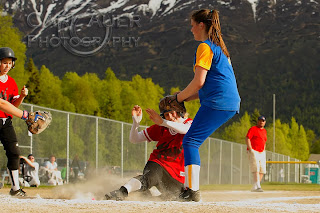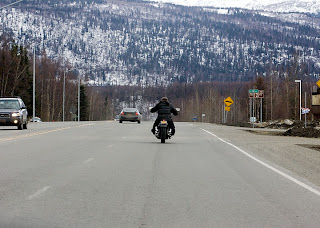


Images, News, and Photo Tips



There have been a couple injuries as of late that I want to touch on.
Alexandra Boulat of Agency VII suffered a ruptured brain aneurysm while on assignment in
Also, at the AST Dew Tour this weekend, BMX Vert champ, Chad Kagy went down hard while trying a triple tailwhip.
I am heading into my last week of Little League Baseball for 2007. No All-Stars this year, but it will give me a chance to focus more on helping my mother in her recovery from heart surgery a little more. Maybe get her back on her feet quicker. It will also give me the chance to photograph some other things I have been putting off. For the last two years I have really missed the

 I am triggering it with a remote I got off of ebay. It is not the little remotes we use for strobes, but one that is really a cable release that comes with a little key chain FOB that will trigger it from about 100 feet away. Typically, I will set it up looking up at third base from behind home plate and prefocus on the area around home with a large DOF to get plays at the plate. In the above picture, I set it up to get batters at a coach pitch game so I could focus on the field action for some sportraits. It is not the best for getting hits, because, unlike Pocket Wizards, there is a major shutter release delay, but for action at the plate, when I see someone rounding third, I start mashing the shutter around the time they get half way to home. Seems to work pretty good for that. As you can see in the image below, the low angle really adds to the image.
I am triggering it with a remote I got off of ebay. It is not the little remotes we use for strobes, but one that is really a cable release that comes with a little key chain FOB that will trigger it from about 100 feet away. Typically, I will set it up looking up at third base from behind home plate and prefocus on the area around home with a large DOF to get plays at the plate. In the above picture, I set it up to get batters at a coach pitch game so I could focus on the field action for some sportraits. It is not the best for getting hits, because, unlike Pocket Wizards, there is a major shutter release delay, but for action at the plate, when I see someone rounding third, I start mashing the shutter around the time they get half way to home. Seems to work pretty good for that. As you can see in the image below, the low angle really adds to the image. Yes, that is me in the lower left of the image. I moved over to third base to photograph the pitcher, and did not realize I was in frame.
Yes, that is me in the lower left of the image. I moved over to third base to photograph the pitcher, and did not realize I was in frame. Alaska welcomed professional football to the state for the first time on April 12th 2007. The Intense Football League, or IFL, kicked off the seasons for the new pro team in Alaska, the Alaska Wild, facing the Frisco Thunder. The IFL is mainly based in the Texas area, and Frisco is located around the Dallas area, although, a lot of the Wild fans at the Sullivan arena for the game thought it was San Fransisco, CA, not Frisco, Texas. Here we see Delvin Myles of the Wild trying to pump up the Alaska crowd but it was not enough as the Wild could only score 33 points against the 46 points by the Frisco Thunder in both teams first game ever. Originally, the Wild were to play in the AF2, a development league for the AFL, or Arena Football League, but due to lack of funds, and a lack of a team at the time, the owners pulled the plug and decided not to have a season until 2008. Then after loosing their first coach (why coach if the games and team are not there), the IFL invited the Wild into their league and once again football was on for the 2007 season. A new head coach was hired and a team was quickly put together. A couple hours after the Wild lost to the Thunder, the ownership of the team announced that the 2nd head coach had been let go for various reasons, one of which was trying to bypass the IFL salary cap to get more money for at least one player. So, heading out on the road, for only their second game ever, the Wild are on their third coach.
Alaska welcomed professional football to the state for the first time on April 12th 2007. The Intense Football League, or IFL, kicked off the seasons for the new pro team in Alaska, the Alaska Wild, facing the Frisco Thunder. The IFL is mainly based in the Texas area, and Frisco is located around the Dallas area, although, a lot of the Wild fans at the Sullivan arena for the game thought it was San Fransisco, CA, not Frisco, Texas. Here we see Delvin Myles of the Wild trying to pump up the Alaska crowd but it was not enough as the Wild could only score 33 points against the 46 points by the Frisco Thunder in both teams first game ever. Originally, the Wild were to play in the AF2, a development league for the AFL, or Arena Football League, but due to lack of funds, and a lack of a team at the time, the owners pulled the plug and decided not to have a season until 2008. Then after loosing their first coach (why coach if the games and team are not there), the IFL invited the Wild into their league and once again football was on for the 2007 season. A new head coach was hired and a team was quickly put together. A couple hours after the Wild lost to the Thunder, the ownership of the team announced that the 2nd head coach had been let go for various reasons, one of which was trying to bypass the IFL salary cap to get more money for at least one player. So, heading out on the road, for only their second game ever, the Wild are on their third coach.
 The snow is hardly off the pavement and the rumble of two wheeled beasts are already filling the spring air of South Central Alaska. Even with the shorter than normal motorcycle season in Alaska, there are die hard riders that will brave the gravel covered roads and the risk of freezing rain or hail, to feel the wind in their hair for as long as they can. Here we see a biker heading up Eagle River Road to the Eagle River VFW on Tuesday, April 10th, 2007.
The snow is hardly off the pavement and the rumble of two wheeled beasts are already filling the spring air of South Central Alaska. Even with the shorter than normal motorcycle season in Alaska, there are die hard riders that will brave the gravel covered roads and the risk of freezing rain or hail, to feel the wind in their hair for as long as they can. Here we see a biker heading up Eagle River Road to the Eagle River VFW on Tuesday, April 10th, 2007.
 Every Spring in South Central Alaska when the snow melts the clean up begins. Here we see Ben, an employee of the Eagle River Holiday Gas Station sweeps up the gravel that once covered the icy parking lot. South Central streets and parking lots are now covered with dust and gravel and the next few weeks will be a massive cleanup from individual businesses, homes, and the Municipality of Anchorage. In order to keep the air quality high, the only thing people can do is sweep by hand or use street cleaners, hosing the gravel down first to keep the dust from getting airborne. Leaf blowers and air compressors are illegal for cleaning the gravel and Anchorage Police are out in force writing tickets for people who do not follow the rules during cleanup time.
Every Spring in South Central Alaska when the snow melts the clean up begins. Here we see Ben, an employee of the Eagle River Holiday Gas Station sweeps up the gravel that once covered the icy parking lot. South Central streets and parking lots are now covered with dust and gravel and the next few weeks will be a massive cleanup from individual businesses, homes, and the Municipality of Anchorage. In order to keep the air quality high, the only thing people can do is sweep by hand or use street cleaners, hosing the gravel down first to keep the dust from getting airborne. Leaf blowers and air compressors are illegal for cleaning the gravel and Anchorage Police are out in force writing tickets for people who do not follow the rules during cleanup time.

 Now I sit here watching March Madness wishing I was sitting courtside shooting away. I get to cover a UAA gymnastics meet this Sunday against Ball State, and at the end of March I will be shooting 4 days of the US Ski Team Alpine Championships at Girdwood and Alyeska Resort. I also have some Alaska Aces games coming up and I am also counting down the days until the Alaska Wild start playing indoor football. My biggest job will take up most of the summer though. I have once again been signed to do the action photos for Knik Little League which, honestly, is a blast to do.
Now I sit here watching March Madness wishing I was sitting courtside shooting away. I get to cover a UAA gymnastics meet this Sunday against Ball State, and at the end of March I will be shooting 4 days of the US Ski Team Alpine Championships at Girdwood and Alyeska Resort. I also have some Alaska Aces games coming up and I am also counting down the days until the Alaska Wild start playing indoor football. My biggest job will take up most of the summer though. I have once again been signed to do the action photos for Knik Little League which, honestly, is a blast to do.